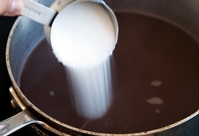I just finished judging at the 8th Critics Challenge International Wine Competition in San Diego. There were 60 excellent wines (whittled down from an entry field of about 1,300) in the sweepstakes round, which made it tough to select the best wine in each of the five categories: sparkling, red, rosé, white and dessert. After some close votes, the final five were G. H. Mumm NV Rosé Champagne, Cakebread Cellars 2007 Merlot, Robert Oakley 2010 Rosé of Sangiovese, Hagafen 2010 Riesling Devoto Vineyards, and Inniskillin 2007 Vidal Ice Wine. G.H. Mumm, which has been on a roll lately, took the Best of Show award with their stellar non-vintage Brut Rosé.
Aside from the quality of the wines, what struck me most was the sweetness of most of the red wines.
And the variety didn’t matter. Cabernet Sauvignon, Merlot, Pinot Noir or Syrah–they were all sweet. The stated residual sugars were not high, often less than 0.5 percent (5 grams per liter), which is the level at which taste physiologists say most people can perceive sweetness.
Syrah–they were all sweet. The stated residual sugars were not high, often less than 0.5 percent (5 grams per liter), which is the level at which taste physiologists say most people can perceive sweetness.
Americans have always professed a stated preference for “dry” wines, but market data indicates they drink sweet. Moët and Chandon capitalized on that dichotomy with their (now retired) “White Star” Champagne. Nowhere on the label did it indicate it was sweeter than a Brut. It was the largest selling Champagne in the US for years. Jess Jackson seized on Americans’ proclivity for sweetness as well when he left a little sugar in his Vintner’s Reserve Chardonnay and watched it climb to the top of the charts in sales.
By contrast, the trend toward sweetness in reds is relatively new, seemingly the current fashion. Wine producers justify the style of their wines by saying that’s what the market demands. And given the success of White Star and Vintner’s Reserve Chardonnay, it’s hard to argue.
Part of the sweetness comes from grape sugar, either glucose or fructose, that is not fermented to alcohol. Gram for gram, fructose delivers almost twice the “sweetness” as glucose.
Another component of sweetness in wine is alcohol. Mary-Ewing Mulligan, a Master of Wine, tells me that adding neutral spirit to wine increases the perception of sweetness up to a point. Then the identifiable “burn” of alcohol (as felt in Cognac, for example) becomes apparent.
Super-ripe fruit is often named as the culprit to explain sweet wines. I don’t know the precise compound(s) in ripe fruit, other than higher levels of unfermented fructose or glucose that impart sweetness, but there are many other naturally occurring sugars, such as erythritol or sorbitol, that bombard the palate with even more sweetness than fructose.
Whatever the reasons, residual sugar, alcohol or “ripeness,” red wines today are sweet, which makes them harder to match effectively with food. While white wine and bubbly lend themselves to aperitif usage, red wines, especially big reds, benefit from being tasted along with food. Producers should listen to the tag line in investment advertisements: Past performance does not predict future returns. Just because White Star and Vintner’s Reserve Chardonnay were popular with consumers for decades, doesn’t mean that sweet reds will please an increasingly experienced public.
2
